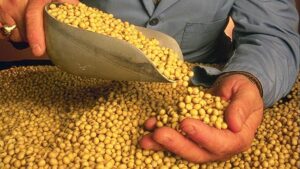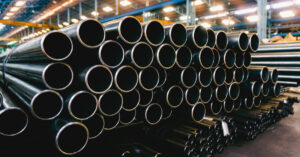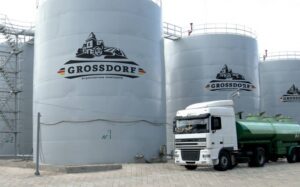
Ruta, a major Ukrainian manufacturer of sanitary and hygienic paper products, whose management company is VGP JSC (Lutsk), produced products worth UAH 281.3 million in January-February, up 13.8% compared to the same period in 2023.
According to Ukrpapir Association’s statistics provided to Interfax-Ukraine, in physical terms, in particular, the production of toilet paper in rolls increased by 8.4% to 21.15 million units, which remains the third best result in the industry after Kyiv Cardboard and Paper Mill (42.5 million units) and Kokhava Paper Mill (24.3 million units).
The company produces cellulose-based sanitary products from imported base paper.
VGP’s brand portfolio includes napkins, toilet paper, paper handkerchiefs, and kitchen towels under the Ruta, Ruta Selecta, Fesko, Nosovic, Polotenchko, 100% paper, Servetta, and Ecolo brands. The assortment includes more than 180 items.
As reported, in 2023, the company produced products worth UAH 1 billion 611 million, which is 64.8% more than in 2022.

Cardboard and Paper Company LLC (Lviv), a major Ukrainian producer of cardboard tubes, produced products worth UAH 194 million in January-February 2024, down 3.7% year-on-year.
According to statistics provided to Interfax-Ukraine by UkrPapir Association, the company reduced its output of cardboard products by 13.8% in physical terms to 4.11 thousand tons, while it increased its production of paper base for sanitary products by 65% to 1.58 thousand tons. The production of toilet paper in rolls increased by 13.2 percent to 0.9 million units.
LLC Cardboard and Paper Company produces products and semi-finished products from waste cardboard (cardboard sheets, corners, sleeves), cellulose and recycled waste paper (toilet paper, towels, napkins under Papero brand). The company supplies its products, in particular, to the EU countries.
Among its customers are Biosphere, Arterium, Nestle, Khlibprom, Yarych confectionery, and Galychyna dairy company.
As reported, in 2023, the company increased its production by 7% compared to 2022, to UAH 1.27 billion.

In 2024, the production of oilseeds in Ukraine will increase by 19% compared to 2023 to 2.3 mln ha, which will be a record for the industry, APK-Inform news agency reported based on the results of the survey among farmers.
According to the survey, conducted in February-March 2024, 82% of the respondents, who grow soybeans, plan to keep the area under soybeans unchanged, and 16% intend to increase it. The increase will be due to the reduction of the area under winter crops, as well as sunflower or other spring crops.
The soybean area in 2024 may increase to 2.3 mln ha (+19% by 2023), which will be a new record for the industry. Previously, the maximum for this crop was 2.2 mln hectares in 2015, analysts predict.
They also expect the production of soybeans in Ukraine to reach a record level, which, according to preliminary estimates, could reach 6 mln tons, which is 17% higher than last year.
At the same time, according to experts, the area under sunflower is not likely to change significantly: 87% of the respondents who grow the crop plan to keep the area under it unchanged. Those who plan to reduce or increase the area under sunflower mostly reported that it will be at the expense of rapeseed.
“Our estimate of the sunflower acreage in 2024 is still 5.8 mln ha, which is almost at the level of 2023. Under favorable weather conditions, the oilseed harvest could reach 13.9 mln tonnes (+1% compared to 2023), which is still lower than the pre-war figure,” the analysts emphasized.
The area under rapeseed in 2024 is likely to decrease due to the dry autumn, which led some farmers to abandon the winter oilseed planting.
In the survey, 51% of respondents reported that winter rapeseed crops are in good or excellent condition, 43% – in satisfactory condition, and 5% – in poor condition.
The area under spring rapeseed may also increase in 2024 to the record level due to the price attractiveness of this oilseed, but the total area under winter and spring rapeseed, according to APK-Inform preliminary estimates, will decrease by 6%. This figure will still remain quite high compared to previous years, amounting to about 1.4 mln ha. The harvest of this oilseed may decline by 9% in 2024, to 4.2 mln tonnes, APK-Inform summarized.

The companies of Ukrtruboprom increased pipe production by 10.2% year-on-year to 495.6 thousand tons in 2023.
According to the association’s data on Wednesday, in 2023, pipe companies showed mixed dynamics.
In particular, Interpipe Nico Tube increased its seamless pipe production by 13.3%, while Trubostal reduced it by 42.5%. Ukrtruboizol increased production of electric-welded pipes by 43.8%, while Interpipe NMTZ decreased production by 53.8%. “Centravis increased production of stainless pipes by 11.7%. Oscar’s pipe production decreased by 30.5%.
At the same time, it is specified that in January 2023, 30.1 thousand tons of pipe products were produced (44.9% compared to January 2022), in February – 39.4 thousand tons (80.4% compared to February 2022), in March – 57.1 thousand tons (1631 tons (1631.4% compared to March 2022). tons (1631.4% compared to March 2022), in April – 42.3 thousand tons (228.6% compared to April 2022), in May – 49.6 thousand tons (96.5% compared to May 2022), in June – 35 thousand tons (67.8% compared to June 2022).
In July 2023, the company produced 43.9 thousand tons of pipes (112% compared to July 2022), in August – 41.8 thousand tons (114.5%), in September – 36.9 thousand tons (89.9%), in October – 39.7 thousand tons (98%), in November – 37.2 thousand tons (110.1%) and in December – 42.4 thousand tons (239.5%).
Georgiy Polskiy, CEO of Ukrtruboprom, noted that the Ukrainian pipe industry showed growth last year. This happened for the first time in two years of full-scale war, despite the proximity of many production sites to the front line and Nikopol being located directly in the war zone, which is subject to constant shelling.
“Against this backdrop, it is logical that we cannot talk about pre-war pipe production volumes: the results of 2023 are only 70% of the level of 2021. However, the production results for the year could have been higher if imported products from China had not entered the domestic market in large volumes, especially when analogues are produced in Ukraine. Chinese pipe products have simply flooded the Ukrainian market, both in the private segment and in tenders of state-owned companies,” stated the head of Ukrtruboprom.
He added that “that is why we were very enthusiastic about the establishment of the All-Ukrainian platform ‘Made in Ukraine’, which can help change the state economic policy.”
“This platform will help to solve the shameful problem of import penetration, in particular, in public tenders, thanks to the constant direct dialog between the state and business. At the same time, support for Ukrainian producers will become one of the key priorities of the government and parliament, which will strengthen Ukraine’s defense capabilities in wartime,” Polsky said.
As reported, Ukrtruboprom’s enterprises reduced pipe production by 37.9% in 2022 compared to 2021, to 449.7 thousand tons. In 2022, all plants showed negative dynamics. “Interpipe Niko Tube and Trubostal reduced production of seamless pipes by 31.1% and 61.6%, respectively, Centravis – stainless pipes by 38.3%, Interpipe NMTZ – electric-welded pipes by 67.1%. Production of pipes at Oscar fell by 20%, and only Ukrtruboizol reached the production level of 2021. Dnipropetrovs’k Pipe Plant has been idle and is in the process of liquidation.

In 2024, IMC Agro Holding intends to expand corn crops and return to pre-war agricultural technology, and is also studying two projects to develop processing, the decision on which will be made in May-June, said Alex Lissitsa, SEO of the agricultural holding, at the Forbes Agrifood conference.
“During the two years of war, we have come a long way. We had 120 thousand hectares and 6 elevators. 100 thousand hectares and 5 elevators were under occupation. As a result of the de-occupation, we managed to enter our territory. However, some facilities were destroyed,” he said.
According to him, the new large dairy farm of the agricultural holding, located on the border with Belarus, had to be closed due to the poor condition of the cows after the occupation, as well as the almost completely destroyed logistics infrastructure around Chernihiv, where all bridges were destroyed.
In the first year, 30 thousand hectares of the agricultural holding’s land were in the war zone and were partially mined. The second year of the war was a stage of rethinking for IMC, and in the third year they managed to reach more or less the planned indicators, explained the SEO of the agricultural holding.
According to him, in 2022, IMC was unable to sow its land and grew mainly wheat. In 2024, the agroholding will return to traditional technological maps and expand the area under corn, as in 2023 it managed to get a record harvest of 20 tons per hectare. IMC was able to achieve such results thanks to favorable weather conditions that offset the problem of fertilizer and pesticide shortages. In addition, the agroholding has the necessary capacity to store corn.
Mr. Lissitsa also noted that IMC refused to cooperate with international traders who behaved incorrectly towards most Ukrainian customers. Currently, IMC prefers to cooperate with the domestic grain trader Nibulon, through which it sells about 70% of its products. IMC has also found new suppliers of sunflower seeds – Ukrainian regional companies in Chernihiv region.
“We used to build relationships with large foreign traders, and now we are establishing partnerships with those we have not communicated with before. We were beautiful, fashionable, and it was not very fun to work with them. And now we realized that we are basically still beautiful, but not so fashionable. And we need to work with local businesses. They offered us a helping hand and we started working again. Now we are really rethinking. Many contracts with international traders are still in court. I don’t know when they will end. Huge amounts of money are stuck there. It is really easier for us to drive up to our neighbors, negotiate and shake hands,” stated the IMC SEO.
Lissitsa also said that most agricultural holdings have not invested in machinery over the past two years, but have been living off the purchase of spare parts, and thus most of the agricultural machinery has been produced.
At the same time, the IMC is considering two processing projects in parallel – one with the EBRD and the other with the IFC.
“I can’t tell you yet, but we are looking at these projects very, very closely and will make a decision in May-June this year,” Lissitsa said.
The agroholding’s SEO emphasized that IMC has no problems with financing and has established partnerships with a number of banking institutions.
“Last year, we were probably one of the first in the agricultural sector to receive a new loan from the EBRD during the war. Raiffeisen financed us for the purchase of machinery. Credit Agricole is now adding more,” Lissitsa summarized and advised farmers to establish transparent relations with banks and be ready to provide them with all the information to get financing for new projects.

Grossdorf, an agrochemical company specializing in the production of granular and liquid mineral fertilizers, has decided to expand its product range by developing a line of products for retail, according to the industry analytical publication Infoindustriya.
“Entering the retail market opens up new opportunities for growth and expansion of the consumer audience. The company believes in the quality of its products and is ready to meet the needs of retail customers with the same dedication it shows in the agrochemical sector,” said Andriy Khalyavka, CEO of the agrochemical company.
According to him, in 2023, Grossdorf produced about 20 thousand tons of different formulas of NPK fertilizers. In addition, the company became the second largest supplier of UAN in Ukraine in 2023 and produced more than 106 thsd tonnes of this fertilizer. In addition, Grossdorf produces granular potassium chloride, NPK fertilizers and granular (compacted) ammonium sulfate.
“In total, the manufacturer supplied more than 150 thousand tons of fertilizers to the market last year, becoming the second largest fertilizer producer in Ukraine,” InfoIndustry summarized.
Grossdorf LLC was established in 2001. The company is a mineral fertilizer producer, one of the leaders in the production of UAN in Ukraine, an importer, supplier and end consumer of mineral fertilizers. The company has its own plant in Odesa region for the production of liquid fertilizers (UAN, UAN, UAN), a storage facility for liquid fertilizers with a capacity of over 10 thousand tons, facilities for the production of bulk granular fertilizers, and an extensive network of agrochemical warehouses in almost all regions of Ukraine.